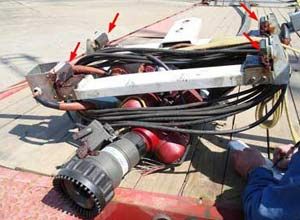By Jamie Thompson
FireRescue1 Editor
 Photo NIOSH A photo taken after the incident shows the waterway. Arrows indicate Nylatron® pads that are greased to aid movement as the ladder extends and retracts. |
Related Resources: NIOSH Incident Report: Volunteer Deputy Fire Chief Dies When Struck by Motorized Water Monitor NIOSH Safety Advisory: Improper Set-up of Aerial Ladders with a Locking Waterway May Put Fire Fighters at Risk |
Departments should review their SOPs/SOGs on multi-position waterways after a firefighter was struck and killed by a motorized water monitor that launched off an aerial ladder truck, according to a NIOSH report.
The report said departments should also contact aerial ladder manufacturers to retrofit existing ladder trucks with secondary stops or other engineering controls to prevent waterways from launching if they are improperly anchored.
The recommendations follow the death in April last year of Deputy Fire Chief Michael Crotty, of the Lawrence Park Township, Pa., Volunteer Fire Department. He was struck by a motorized water monitor and 30 feet of aluminum pipe propelled from an elevated aerial ladder at an industrial fire.
When the waterway was pressurized, the monitor and its support bracket, along with the last 30-foot section of pipe, were launched off the aerial ladder by the force of the water in the pipe. The mechanism flew approximately 75 feet and fell, striking Deputy Chief Crotty on the head, killing him instantly.
After the incident, the waterway anchor pin was found on the ground, in front of the truck’s cab, according to NISOH investigators. The waterway did not include secondary mechanical stops to prevent the separation of the water monitor in the event the anchoring pin was not properly seated.
The report listed several factors that could have contributed to the death:
- The original equipment design (lack of secondary mechanical stops to prevent separation in the event the anchoring pin was not properly installed).
- The delay in responding to the incident, firefighters’ knowledge that they were responding to a verified fire, and the delay getting water to the apparatus due to a frozen hydrant cap, could have added to the stress of the members operating around the apparatus.
- Five different individuals took part in setting up and operating the apparatus for master stream operation. The critical task of setting up the waterway for master stream operation (which included pinning the waterway) was assigned to a probationary firefighter with little experience at the task and the task was performed unsupervised. When the aerial ladder operator arrived on the scene, he was unaware that anyone had touched the pin and assumed that the monitor was secured in the travel mode at the second section.
NIOSH investigators said that, to minimize the risk of similar occurrences, fire departments should:
- Ensure that Standard Operating Procedures (SOPs) and/or Guidelines (SOGs) for setting up multi-position waterways include steps to properly position the waterway and to inspect and verify that the locking mechanism (anchoring pin(s), lever, clamps, etc.) are properly installed and functioning as designed before pressurizing the waterway.
- Provide training and practice for firefighters on the correct method of securing waterways and verifying they are secured per manufacturer’s recommendations.
- Ensure critical tasks are properly supervised.
- Contact aerial ladder manufacturers to retrofit existing aerial ladder trucks with secondary stops or other engineering controls to prevent waterway launches in the event the waterway is improperly anchored.
The report has also recommended that fire apparatus manufacturers should provide aerial ladder trucks with secondary stops or other mechanical means of preventing inadvertent waterway separation or launch.
As part of this investigation, NIOSH said a number of fire apparatus manufacturers were contacted about the use of mechanical stops at the end of the fly section to prevent the slider from coming off.
Three aerial manufacturers indicated that they felt that the waterway traveling at high speed up the ladder, then striking a rigid stop, might cause serious damage to the aerial device or causing a firefighter standing on the ladder to be knocked or thrown off, the report said.
Two manufacturers indicated that they do add stop blocks but the result of hitting them with the slider under pressure is unknown.
NIOSH investigators said the presence of mechanical stops on aerial ladders may prevent waterway separation or launching, and that the NFPA should establish standards that include engineering safeguards to prevent inadvertent waterway separation.
In a safety advisory issued after the death, NIOSH said while newer aerial ladder trucks may incorporate different types of anchoring mechanisms and/or a more fail-safe design, proper set up still needs to be verified before operation.
The pin-anchored waterway design involved in this particular investigation is not limited to a single model or apparatus manufacturer, it added. During this investigation, NIOSH became aware of at least 10 similar incidents that occurred in Delaware, Michigan, New Jersey, Texas, Virginia, California, Minnesota, Missouri and Ontario without serious injury.

